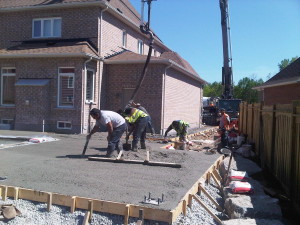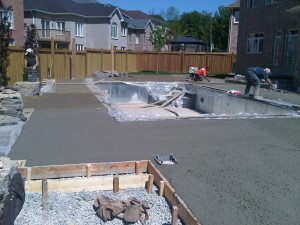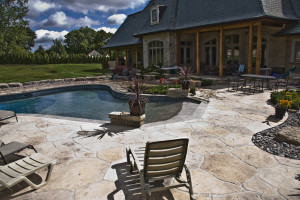The installation process
For stamped concrete swimming pool surrounds, the stamping process begins as the concrete is being poured. When watching this process, which usually involves pressing moulds into the concrete during the curing stage, it appears to be an overwhelming job; however, most installation teams have a well-oiled system. A successful project starts with the proper preparation and installation of the subgrade, which is the most vital part of the job.


Before the concrete is poured, the subgrade must be excavated first and a 152-mm (6-in.) bed of 19-mm (0.75-in.) granular stone applied. Then, concrete is poured and floated, and a colour hardener is applied. The wet cement is trowelled and the stamp is applied to create the dimensional characteristics of the selected pattern.
Finally, the surface is sealed to facilitate curing and to enhance the colour. As an option, grouting may be applied to augment the appearance. Other popular styles include wood board with an authentic weathered look (including nail holes), square stone, which replicates sawed keystone found in the Florida Keys, or even volcanic looking stone with coarse ridges, chisel marks, and craters.
Attention to detail
Specialized concrete contractors pride themselves on being detailed oriented, thus leaving behind a dependable project. In addition to design selections, another consideration for the homeowner is cost. When a client invests in a large project, they want to avoid costly mistakes or an improper installation, which may need to be repaired after a short time. Therefore, a licensed and/or trained concrete professional should be able to install a concrete swimming pool surround with the desired look the client wants to achieve with very little problems.

Concrete may be a more labour intensive material to use during the building process; however, in comparison to wood, which requires staining and has a shorter lifespan, concrete will outperform wood in almost all cases. Further, paving stones, which may heave and allow weeds to grow through, can also be detrimental for some projects. That said, it should be explained to clients that despite the additional costs, using concrete is worth the extra time and effort to ensure a long-lasting, maintenance-free hardscape.
Today, more backyard designs include elegant, sophisticated additions such as hot tubs, cabanas, and outdoor kitchens to enhance the main goal of these projects, which is fun. Of course, the swimming pool is often the centre of attention in any backyard landscape plan, while concrete is one of the main materials used in the design. The eye is often drawn to the swimming pool and the rippling effect of the water; however, sooner or later, the scrutiny comes to the deck with respect to its overall appeal and usefulness. While brushed concrete is effective and will do the trick, stamped, coloured concrete swimming pool surrounds can add to the overall landscape by giving the outdoor living space character.






